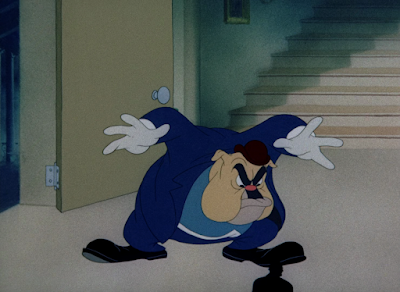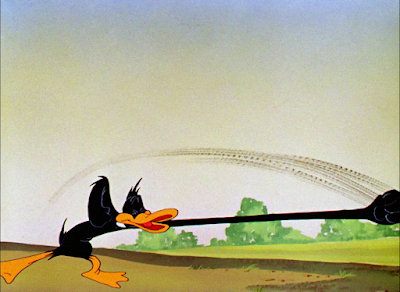The Milkman is a cartoon with three not-all-together acts. The first part of the short features Toby the Pup delivering milk with his horse and wagon with a series of gags, bottles landing here and there, and the horse deciding to go to sleep.
Next, Toby abandons his horse in a little car conveniently in his wagon, and runs into a storm, with rainfall jokes taking up footage.
Our hero (and a small tree) take up refuge in a house which, somehow, has a huge dance hall, and we get musical jokes to finish off the short.
The Toby shorts, and there were 12 of them made by the Winkler (Charles Mintz) studio for release by RKO, are kind of Fleischer Light. Considering Dick Huemer was involved in them, that’s not much of a surprise, but they don’t have as many unexpected throw-away gags as you’d find in a Bimbo Talkartoon short.
The Milkman does have some enjoyable bits. After the horse blows a steam whistle, Toby throws away his bottles.

He reaches into a hidden pocket to put gloves over his gloves.

Next, he reaches behind himself to pull out some spats, which he wears after putting them on over his head.



Now he pulls something out of his belly button. At first, it looks like a cane, but it’s actually a top hat.



Hidden under his, uh, fur, is a cigar and a cleaver, which he uses to chop off the end of his cigar.




Why Toby decides to put on formal wear isn’t apparent, at least to me.
Harrison’s Reports of the day listed the release date as February 20, 1931 while the
Motion Picture Herald gave February 25. Despite that,
The Film Daily of July 21, 1930 reported “Animation for ‘The Milkman,’ third of the ‘Toby, the Pup’ cartoons has been completed, according to the report from Mintz. It is now in the recording room.” There is a
York Daily News-Times ad for the cartoon on the bill at the York Theatre on October 12, 1930. Toby lasted one season. RKO already owned Van Beuren Productions, which made Aesop’s Fables, and replaced Toby with in-house animated shorts starring the human Tom and Jerry.


























































